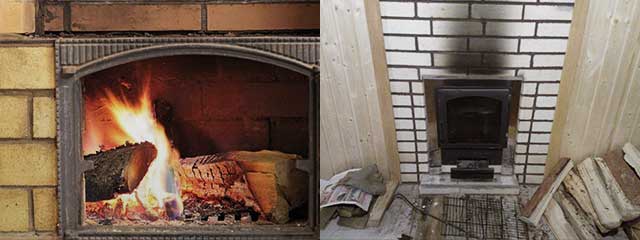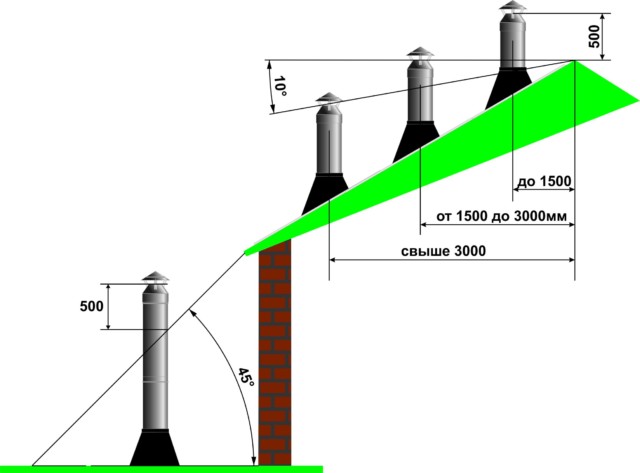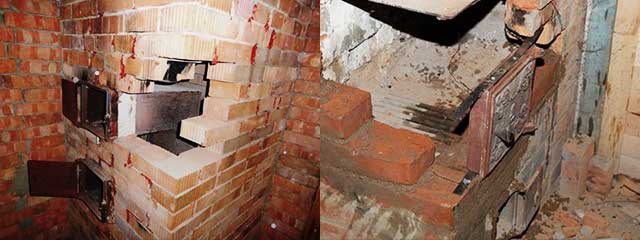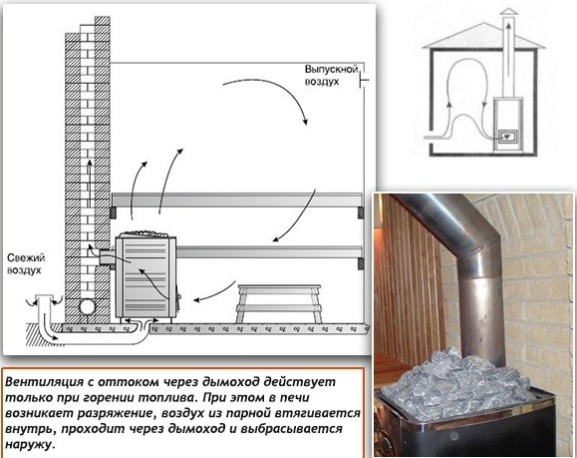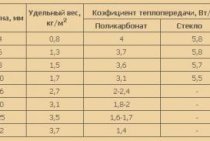What to do if a recently installed stove smokes? Often the cause of smoke is structural inconsistencies, non-compliance with the technology of the masonry process, insufficient ventilation, and the absence of a junction box.
The main cause of smoke in new furnaces is the miscalculation of the height of the chimney. Heating equipment for a Russian bath and a private house must comply with the following parameters:
If the height of the chimney is insufficient to prevent smoke, then it can be increased independently.
Why does the stove smoke when the door is opened during the kindling process? A similar problem arises in the presence of serious design miscalculations: an incorrect section of the outlet pipe, a low location of the inlet channel, an unswept chimney. To eliminate the shortcomings, a major overhaul of the heating equipment will be required.
The required clearance of the chimney ensures quick and safe removal of combustion products. The minimum pipe diameter for a house is 15 cm, for a bathhouse - 10 cm. The height of the pipe and its installation location on the roof must correspond to the chosen design of the heating furnace.
In addition, the inlet to the first well (in the combustion chamber) must be located no lower than the top of the door, otherwise it may lead to smoke with each kindling of the furnace. You can correct the shortcomings only by restructuring the furnace design.
When assembling the chimney, the use of elements of different sections should be avoided, which can be the main cause of smoke in the furnace. The best option is a round pipe. Rectangular flue ducts can create excess air vortices and increase the deposition of soot.
Another reason why a new stove starts to smoke is poor ventilation. As a rule, when equipping a forced-type ventilation system, the owners of the building provide for an exhaust hood only in functional rooms - a sanitary unit, a kitchen or a dressing room. However, a separate smoke channel should also be equipped in rooms where normal movement of air masses is required: in the steam room and washing room.
If two heating stoves are installed in the building, for which a common flue system is provided, then smoke occurs as a result of the absence of a junction box.
To eliminate such a problem, it is enough to make a junction box with two separate channels or operate the furnaces in turn.
VIDEO ipt>
The junction box is a special brick partition located inside the common chimney.
Why does the fireplace smoke What are the reasons
If the fireplace still smokes, then what reasons most often lead to this? And is there any way to get rid of the smoke?
The problem may be in the design of the fireplace itself and its chimney:
Violation of the correspondence between the dimensions of the chimney and the opening of the fireplace. The volume of the chimney does not have time to remove combustion products from the fireplace insert.
The low location of the mouth of the smoker. The smoke, rising, rests against the upper edge of the hole and flows into the room.
When the back wall has a large slope, the smoke is reflected from it and floats towards the room.
If there is insufficient fresh air supply, low pressure can be created, which provokes back draft.
The reason that the fireplace smokes may be a leaky firebox.This may occur when the firebox is made of thin metal sheets.
Smoke can go into the room both with a shallow and with an excessively deep firebox. In this case, the depth of the furnace should be corrected.
When a chimney is connected to another at a 90° angle without using a cut, this problem may occur. In this case, the chimney duct system needs to be redone.
Errors in the location of the soot pans (technological pockets through which soot is removed and the chimney is cleaned) can also lead to the appearance of smoke. Because of this, it is difficult to clean the chimney, which leads to the fact that its passages are clogged.
The negligent attitude of the stove-maker to the masonry, or the use of low-quality building materials, leads to the appearance of cracks in the masonry array. This is especially common in attics and chimneys. Air is sucked in through these gaps. Lost traction.
The cause of traction problems can also be an incorrectly selected damper. In this case, you can replace it with a swivel frameless.
When the chimney has uneven walls, unsmoothed corners in the area of \u200b\u200b"folds" and "passes".
The draft can also be broken if the chimney ducts are clogged with debris, mortar residues, brick fragments.
The reasons that are easier in terms of the degree of elimination include improper operation of the fireplace:
The paper bundle is kindled at the smoke box.
The chimney in the attic is not insulated.
The formation of drafts, possibly due to open windows near the fireplace. This leads to a rarefaction of air near the portal.
Frequent abrupt closing of doors (“slamming”) can cause a sharp change in the pressure level in the room.
When operating a fireplace, it is useful to remember that it is, first of all, a heat engineering device. It must comply with numerous requirements of sanitation and hygiene, and of course, comply with all fire safety requirements. Negligent attitude to the rules of operation of the fireplace and its construction can lead to fire and carbon monoxide poisoning. Regular preventive measures, such as cleaning and repair, can keep and maintain its normal operating condition.
What should be done so that the furnace does not smoke
There are many types of ovens. I have a stove with a built-in boiler for water heating. In my opinion, the most important thing is the chimney, smoke channels and cleaning places.
Smoke channels. You need to know their location, number, how they pass and whether they are in your oven.
If there are smoke channels, then there must be places for cleaning. Cleaning doors are usually installed. I don't have them, I have to. In places where the furnace is clogged, ordinary bricks are located. They are simply pulled out and, after cleaning, re-inserted into place, sealed with mortar. It is very uncomfortable. I have two cleaning places. One is located on the back wall of the furnace opposite the boiler. The second is at the location of the gate, on the back wall. You don't know what a shiber is? I didn't know either, now I do. What an interesting name - shiber. A gate is called a conventional damper, which allows you to block the smoke channel after the firebox, changing the intensity of the draft. My shaver looks like this.
gate
Tip 1.
When buying a house, be sure to find out from the previous owners: what is the stove, its design. Where are the cleaning doors located? On the roof, inspect everything and sort it out. Find out how the chimney is cleaned, by what means. When was the last time everything was cleaned?
We fix the problem on our own smokes a fireplace, causes and ways to deal with smoke
What to do if there is such a nuisance as smoke entering the room? Do not panic, because even ordinary precipitation (rain, snow, fog) can become the reasons. Usually, with the improvement of weather conditions, the problem is eliminated by itself.
If the fireplace is installed in a country house or in a country house, then it is possible that after a long break it may smoke a little for a while, as the chimney freezes.Do not panic if a little bit of flue gas gets into the room during the first kindling. It happens.
Alas, often the cause of the malfunction is the improper operation of the unit.
Remember, the fireplace is not allowed:
Burn with damp or dirty firewood;
Use too large logs that take up all the space in the oven.
Use flammable liquids;
Leave the fireplace uncleaned of ash.
Cleaning of the combustion chamber and ash drawer should take place when the fireplace has already cooled down.
Small defects on the inner surface of the walls
Eliminated the visible causes of smoke, but the stove still continues to smoke? Another reason for this is cracks on the walls of the chimney, furnace compartment. Cold air penetrates through these cracks, lowering the temperature level, as a result of which the furnace smokes. What to do to get rid of small cracks? For this you need:
Clean the surface by widening the cracks with a chisel.
Prepare a liquid primer by mixing cement with water, and carefully coat the cracks.
While the treated surface dries, prepare a clay grout for plastering, taking 2 parts of clay and 1 part of sand. In order to increase the strength of the mixture, add 0.1 parts of asbestos. Add as much water to the crumbly mixture as needed to achieve a thick consistency.
Cracks are filled using a triangular trowel, the surface is leveled and rubbed with a wooden float.
Leave the plaster and wait until it is about 80% dry.
A finishing layer of grout is applied from above, carrying out an independent repair of the furnace, moving in the direction from below.
After waiting for the surface to dry completely, moisten a wooden grater in water and wipe the remaining irregularities, performing smooth circular motions.
Remember that small cracks that form in tiled cladding are rubbed with a solution based on alabaster and chalk.
Experts recommend replacing tiles with significant defects. New and whole products are placed on a solution of clay or fireclay mortar.
Causes
Having analyzed all the situations by type, let's move on to listing the reasons why the smoke starts to go in the opposite direction. Let's answer the question, why does the fireplace smoke?
All causes can also be classified. They will be divided depending on whether the reason lies in a design flaw or in incorrect operation.
The geometry of the fireplace is taken arbitrarily. The ratio of the size of the firebox to the dimensions of the fireplace affects the formation of traction. If the master made a mistake at this stage, then it remains only to radically correct it.
Here you will need to pay special attention to the height of the pipe. Insufficient height will not provide the proper pressure difference.
All bends and knees are an additional obstacle resulting in reduced traction.
The quality of a brick or prepared mortar often leads to the formation of cracks. They can also cause improper operation of the fireplace. In any case, gases enter the room through these cracks.
What to do if the fuel is raw? It is better to completely abandon the kindling of the fireplace with raw wood. More smoke may simply not have time to evaporate.A kind of plug will form in the furnace, which will force the combustion products to exit through the door into the room.
There are several reasons that are characterized by the state of the chimney itself. On inspection, the canal turns out to be clogged with fallen leaves, fallen brick, or a fallen bird's nest. After removing the blockage, traction is restored.
Fireplace cleaning and preventive maintenance are mandatory procedures. On the walls of the chimney, soot forms exponentially. Soot and soot deposits are themselves centers for the growth of new formations. If you skip a chimney cleaning session, this will certainly lead to the earliest appearance of smoke in the room.
Natural phenomena can also be the cause. Low atmospheric pressure or wind with precipitation results in reverse thrust. Since nature cannot be corrected, in this case it is recommended to wait out adverse conditions.
Reasons why the stove may smoke
The reasons may be different, including because the furnace needs repair. You can read more about oven repairs here.
The reason for the smoking of the furnace can be identified far from one.
If your chimney is not equipped with a windshield, blowing may also occur in windy conditions. Once good weather is set, simply install the hood.
When smoking from the door and / or blower, there may be an overgrown tree that does not allow air to escape freely and beats off gusts of wind into the pipe. This creates a reverse thrust and therefore the smoke to the idea is not where it should be. The solution to the problem is very simple - remove the overgrown branches and free up space in the radius of the pipe.
When the pipe is located below the roof ridge. This is also the reason for the violation of air exchange. To eliminate the cause, it is necessary to build up the pipe.
Bad weather in the form of wind, rain, low temperatures led to the partial destruction of the masonry. The wind blows into the gaps formed, air jams appear and this prevents normal traction. Worth not delaying to make repairs.
Poor-quality cleaning door, which is not able to tightly cover the cleaning hole. In this case, temporarily fill this space with a piece of brick coated with a clay solution. But remember, this is a temporary measure.
If you use firewood, the remains of vegetation from a personal plot, brushwood, straw for the stove, it is worth increasing the length of the blower. How? Put half a brick flat or on edge at its end.
With a defect in the combustion chamber. This can be determined by seeing the smoke when opening the door. If a welded oven is located in close proximity to it, place bricks along it on the edge flush with the door frame fan. If the gas outlet channel is made below the firebox door or at its level, make a bridge of bricks at the back wall of the firebox at the level of the top of the firebox door. This will help create traction.
There are cases when smoke passes through a loosely closed summer valve and has such a whitish tint. Look for a foreign object in the pipe (a broken piece of brick, a branch, etc.). It is possible that the chimneys have not been cleaned of soot for a long time.
Sources
https://ochg.ru/kaminy/montazh/pochemu-dymit-kamin.html
http://openfile.ru/remont/%D0%BF%D0%BE%D1%87%D0%B5%D0%BC%D1%83-%D0%B4%D1%8B%D0%BC%D0% B8%D1%82-%D0%BA%D0%B0%D0%BC%D0%B8%D0%BD-%D0%B2%D0%BE%D0%B7%D0%BC%D0%BE%D0% B6%D0%BD%D1%8B%D0%B5-%D0%BF%D1%80%D0%B8%D1%87%D0%B8%D0%BD%D1%8B.html
https://dekoriko.ru/kaminy/pochemu-dymit/
http://opechkah.ru/pechi/pochemu-dymit-pech
https://www.syl.ru/article/354667/pochemu-dyimit-pech—vozmojnyie-prichinyi-i-ih-ustranenie-kirpichnyie-pechi-remont-pechi
https://SdelatBanyu.ru/pechi-i-dymokhody/pochemu-dymit-pech.html
https://zenplanter.com/answer/pochemu-dymit-pech-i-kak-s-etim-borotsya/
http://kpbd.ru/articles/chto-delat-esli-dymit-kamin.html
http://alemaksi.ru/stroitelstvo-doma/pochemu-dimit-pech-html/
http://derevnya-rus.ru/%D0%B4%D0%B5%D1%80%D0%B5%D0%B2%D0%B5%D0%BD%D1%81%D0%BA%D0%B8 %D0%B9-%D0%B4%D0%BE%D0%BC/%D0%B4%D1%8B%D0%BC%D0%B8%D1%82-%D0%BF%D0%B5%D1% 87%D1%8C-%D1%87%D1%82%D0%BE-%D0%B4%D0%B5%D0%BB%D0%B0%D1%82%D1%8C.html
What to do if the fireplace smokes
Furnace Master
Understanding the reasons why the fireplace smokes, and then eliminating them, can be difficult. Below we consider the most likely of them. These may be design and installation errors, as well as improper operation.
Design errors
For a fireplace, it is very important to choose the right dimensions, which are calculated based on the area and volume of the heated room, and observe their proportions.
Particular attention should be paid to the design of the chimney
– Unsuccessful design of the smoke box. With a small volume of the smoke box, or hail, the smoke does not go completely into the chimney. The same thing happens with insufficient cross-sectional area of the chimney. With too much hail volume, insufficient vacuum is created. The smoke box needs to be modified.
- Furnace. The depth of the firebox should be in relation to the height of the fireplace portal from 1/2 to 2/3. If the firebox is too deep, it can be laid; if it is shallow, increase it. If the smoke tooth is too low, the fireplace may also smoke. An extra row of bricks placed on top of the smoke tooth may solve the problem.
- The design of the chimney. The height of the chimney for the fireplace must be higher than for a conventional stove. The cause of smoke may be a narrowed pipe head, or the lack of wind protection on it. The cross section of the chimney must match the size of the fireplace. If the damper restricts the smoke passage, it should be replaced.
The chimney pipe can be connected to an existing chimney. In this case, all connections and turns should not have right angles, thereby creating additional resistance.
To eliminate smoke, the chimney needs to be modified. In this case, joints made at right angles are disassembled. Vertical pipe joints are recommended to be made at an angle of 60° from the horizontal.
You may need to install additional cleaning to remove soot.
An unsuccessful blower design can also be the reason why the fireplace smokes. It's all about the reverse thrust that the blower can create. In this case, it will be enough to close it.
With insufficient oxygen supply, the burning of firewood will be sluggish, and the flame will have a dark color.
Poor installation
The use of poor-quality materials for masonry mortar can cause cracks in the chimney, or burnout, especially in the attic. Air leakage will worsen traction. The chimney can be clogged with construction debris and mortar.
Uneven chimney walls will additionally collect soot. Insufficient insulation of the chimney in the attic can also cause smoke. To eliminate it, it is necessary to carefully examine the pipe and close the cracks.
Plastering the pipe will additionally insulate the chimney.
Operational reasons
The cause of smoke will be damp, rotten and dirty firewood, or drafts. Do not unnecessarily open windows and slam doors. Perhaps the chimney has not been cleaned for a long time, and it is clogged with soot.
Practical tips for eliminating smoke
If the ratio of the dimensions of the fireplace portal and the pipe is not met, you can try the following. An asbestos-cement strip is taken, the width of which is somewhat greater than the width of the fireplace portal, and applied from above to the smoking fireplace. The area of the portal decreases, and the fireplace stops smoking.
Now you should lift the strip up, gradually increasing the area of \u200b\u200bthe portal, until smoke appears. Thus, the optimal position of the strip is found when there is no smoke and the portal has the largest cross section.
Now it remains to install a stationary decorative curtain from a strip of metal instead of a strip of asbestos cement.
VIDEO It is possible to eliminate smoke by changing the upper section of the smoke box, or by installing a metal plate on the smoke tooth. It is possible to install a metal hail having the appropriate dimensions.
To increase the cross-sectional area of the chimney, you can try to cut off the edge of the tooth - this technique is quite risky and is used as a last resort. To determine where the smoke goes during combustion, a mirror is used.
If the room has supply and exhaust ventilation, this can cause smoke. Turn off the ventilation and look at the result.
This solution can be effective if the pipe height is insufficient, however, it has a number of disadvantages. The danger lies in the fact that in the event of a power outage, an idle fan will create additional resistance to the exit of flue gases.
If this happens during a night's sleep, the consequences can be very sad.
Smoke during kindling
The stove smokes when kindling in the cold season. This problem often occurs with stoves that are used intermittently. For example, the unit is in a bathhouse or a country house. A column of cold air forms a plug in the chimney that blocks the draft. The stove-makers are advised to get rid of it in the following ways:
bring a burning torch to the smoke collector,
burn a piece of paper directly near the smoke box.
These techniques allow the cork to warm up, rise and go out. The problem of cold plugs occurs not only with brick, but also with metal stoves, which are installed in the bath and sauna (heaters). If the house is 2-story, you should be aware that often the cork is collected in the horizontal part of the chimney, if it is on the 2nd floor. According to the masonry technology, the length of this segment (box) should not be more than 2 m.
Smoke from the stove due to the wrong height of the chimney
Often outside the pipe is built of insufficient height. There is a rule according to which it must exceed the height of the roof ridge by an amount depending on the distance to it:
by 0.5 m at a distance from the ridge up to 1.5 m;
not lower than the level of the ridge, if the distance from it is 1.5-3 m;
not lower than an angle of 10 ° from the level of the ridge at a distance of more than 3 m.
If these conditions are not met, the stove will smoke due to insufficient traction and wind from the street. This error can be corrected only by building up the chimney. In case of severe wear and tear, a major overhaul is carried out. It involves the restoration of masonry and the lining with a metal pipe.
Solution
Before proceeding with the elimination of smoke, the cause should be identified. If it is in the wrong design of the system itself, then you can try to fix it in several simple ways:
When the ratio of the size of the fireplace portal and the pipe do not match, then this can be corrected with an asbestos-cement strip. Its size should be slightly larger than the width of the portal. Then the strip is located sequentially at different distances in such a way as to select the optimal level of the portal, eliminating smoke. When this point is found, the asbestos cement is simply replaced with a special decorative metal curtain that is attached to the fireplace.
An alternative option to eliminate this phenomenon is to equip a special metal plate on the smoke tooth, which reduces the cross section of the smoke box.
Forced ventilation. To improve draft, special fans are installed inside the fireplace channels, directing the flow in the right direction.
In such cases, only experienced professionals should be trusted.
The quality operation of the fireplace also depends on the fuel. It is undesirable to use wet firewood, since water not only takes away thermal energy, but also contributes to the formation of soot in the chimney. Also, do not constantly drown with pine or spruce, which leads to a similar effect. The best option is the periodic change of tree species (oak, aspen, pine, etc.).
Types of smoke
It turns out that the fireplace can smoke in different ways. By the type of smoke, you can quickly find possible causes, so first of all we will try to provide a classification by which it will be easy to correct the current situation.
The reason that the wisps of smoke go into the room is the reverse draft. This is a phenomenon in which the movement of gases in the opposite direction is observed.Various types of violations in the functioning of the structure lead to reverse thrust, but the global reason is the same - the pressure in the room is lower than the pressure outside.
A change in the direction of thrust (overturning) is characterized by the fact that under the influence of the determining factor, a local emission of smoke from the furnace occurs. This could be the opening of a window or door. Usually, when the cause is eliminated, the draft in the fireplace returns to normal.
Often there are no complaints about the operation of the fireplace, but when kindling smoke in the room, it cannot be avoided. This group of smoke includes situations where a similar phenomenon is observed when putting firewood into the furnace.
In a separate group, cases are singled out when even the high temperature of the fireplace does not help. During operation, smoke comes out of the furnace, it flows from corners and cracks without ceasing.
If the fireplace smokes how to check for back draft
One of the reasons for the appearance of smoke in the room may be the reverse draft in the fireplace. It is easy to check its presence. Why is it formed?
Two factors influence the draft - the pressure of the flue gases and the air exchange system (air in the room - the furnace part - the chimney - the atmosphere from the outside - again the room). Her work affects the draft in the fireplace. If one of the elements is changed, this can serve to create reverse thrust.
There are several ways to check the draft in the fireplace:
With the help of special measuring instruments;
With a sheet of toilet paper, watching his deflection;
Movement of cigarette smoke.
If the problem is not related to the design, it is worth checking if the ventilation is broken. Its complete absence in the room, or constant drafts can be the cause of reverse thrust.
The color of the flame when kindling can tell exactly if there is a malfunction in the pipe. If the thrust is not enough, the fire will be dark red, and vice versa, with more - the flame will be white, the ideal color for it is golden yellow.
Soot buildup
The most common source of draft deterioration is soot sticking to the walls of the chimney. The inner diameter of the pipe becomes so narrow that the smoke, accumulating, escapes through any slots in the unit body. The degree of soot sticking does not depend on the location of the furnace: in the bath or in the house. Improper operation and certain types of burned wood contribute more to its formation. The first factor is insufficient insulation of the chimney, and the second is the burning of coniferous logs. The only way to repair in this case is to clean the chimney.
How to clean a chimney?
For the mechanical method of cleaning, special devices are required:
ruff, rope, kettlebell.
First, a weight attached to a cable is lowered into the chimney. So you can find an obstacle or a place where the pipe narrowed. If you need to push some object that blocked the channel, the weight is thrown down with force. At the next stage, the pipe is cleaned with a ruff. It has the shape of a square or round brush, its dimensions should be slightly larger than the pipe opening. With downward movements / the chimney is cleaned of soot and accumulated small debris.
Best Answers
20090114:
Does your fireplace have a tooth? If not, bring the fireplace to the doctor!!! or the doctor to the fireplace!!!
Elena Lukyanova:
Maybe the pipe is not high enough and there is not enough traction?
Marina Sakharova:
Traction is bad. If it was normal before, check the pipe and blowers. Maybe something needs to be cleaned up. It also happens in strong winds.
minchat:
It is first necessary to heat on a low fire, but most likely the pipe is clogged. There is such a joke! a bird's feather is lowered into the chimney and fucked up ... there will be smoke at the house. . in general, call chimney sweeps or stove workers !!!
Dmitry Sapotko:
as a rule, incorrect laying of the "beak" or "vault" of the fireplace.
IREN:
..it happens that builders do it on purpose .. to remember them for a long time! did they trust them???
improperly folded ... so it smokes ... shifting ...
User deleted:
I think there are two reasons. 1 chimney stacked incorrectly.(poor draft) 2 Insufficient deepening of the combustion chamber.
Kostya Komar:
Fireplace re-folded? If it’s brand new, then let the specialists who assembled it ensure normal operation. And if the fireplace was previously used, then clean the channel. Maybe there's a dead dove in it. They love to warm themselves by the chimneys, and then by chance they fall there and die there.
